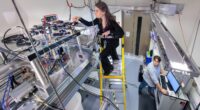US economic output grew at a blistering 3.8 per cent annual rate in the third quarter, whilst employment and hours worked barely increased, creating a significant divergence that economists suggest could signal an artificial intelligence-driven productivity boom comparable to the internet revolution of the 1990s.
The unusual gap between gross domestic product growth and employment data indicates labour productivity potentially grew around 3.5 per cent on an annualised basis, reports The Wall Street Journal. Federal Reserve Bank of Atlanta models predict robust GDP performance, while payroll processor ADP estimates that private payrolls shrank in September.
Citigroup economists compare current AI investment patterns to the internet boom that began in 1995, noting that annual AI equipment spending has risen by 0.9 per cent of GDP since 2023. This represents a bigger surge than the equivalent point of the 1995-2004 internet revolution, when productivity growth eventually averaged 2.9 per cent annually.
“While it is probably premature to ascribe all of the acceleration to AI, these industries have some of the strongest use cases for AI technology,” Goldman Sachs analysis noted, highlighting productivity gains concentrated in technology, scientific research, engineering and consulting sectors.
Artificial intelligence adoption has accelerated rapidly across workplaces, with Gallup finding that 19 per cent of employees used AI a few times or more weekly in June. Walmart recently said the retailer would keep employment flat in the next three years as AI would transform “literally every job.”
However, challenges persist for the widespread implementation of AI. A report published by Nanda, an AI initiative at MIT, found that 95 per cent of 52 organisations surveyed had a zero return on their AI initiatives, suggesting that the technology has yet to significantly impact aggregate economic productivity.
Citigroup estimates AI could raise productivity growth by 0.5 to 1.5 percentage points annually, though Deutsche Bank economists warn that, unlike the 1990s tech boom, current conditions include ageing populations and reduced immigration flows that could limit disinflationary benefits from productivity gains.











